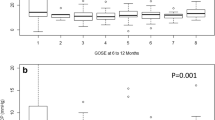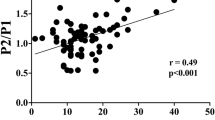Abstract
Objective
We introduced ‘compensatory-reserve-weighted intracranial pressure (ICP),’ named ‘weightedICP’ for brevity, as a variable that may better describe changes leading to mortality after traumatic brain injury (TBI) over the standard mean ICP.
Methods
ICP was monitored prospectively in over 1023 sedated and ventilated patients. The RAP coefficient (R—correlation, A—amplitude, and P—pressure) was calculated as the running correlation coefficient between slow changes in the pulse amplitude of ICP and the mean ICP. RAP has a value of 0 on the linear part of the pressure–volume curve and a value of + 1 on the ascending exponential part. Then, RAP decreases towards zero or even becomes negative when ICP increases further—a phenomenon thought to be related to the critical closing of cerebral vessels. In this study, we investigated a derived variable called weightedICP, calculated as ICP*(1 − RAP).
Results
Mortality after TBI was associated with both elevated ICP and weightedICP. Analysis of variance showed higher values of test statistics for weightedICP (K = 93) than for ICP (K = 64) in outcome categorization. Additionally, receiver operator curve analysis indicated greater area under the curve for weightedICP (0.71) than for ICP (0.67) with respect to associated mortality; however, the difference was not statistically significant (p = 0.12). The best threshold (maximizing sensitivity and specificity) was 19.5 mm Hg for mean ICP, and 8 mm Hg for weightedICP. Mortality rate expressed as a function of mean ICP and weightedICP showed an ascending profile in both cases.
Conclusion
The proposed variable shows a significant association with mortality following head injury. It is sensitive to both the rising absolute ICP and to the critical deterioration of pressure–volume compensation.




Similar content being viewed by others
References
Alberico AM, Ward JD, Choi SC, Marmarou A, Young HF. Outcome after severe head injury. Relationship to mass lesions, diffuse injury, and ICP course in pediatric and adult patients. J Neurosurg. 1987;67(5):648–56.
Chesnut RM, Temkin N, Carney N, Dikmen S, Rondina C, Videtta W, Petroni G, Lujan S, Pridgeon J, Barber J, Machamer J, Chaddock K, Celix JM, Cherner M, Hendrix T, Global Neurotrauma Research Group. A trial of intracranial-pressure monitoring in traumatic brain injury. N Engl J Med. 2012;367(26):2471–81.
Hutchinson PJ, Kolias AG, Czosnyka M, Kirkpatrick PJ, Pickard JD, Menon DK. Intracranial pressure monitoring in severe traumatic brain injury. BMJ. 2013;346:f1000.
Cushing H. The third circulation in studies in intracranial physiology and surgery. London: Oxford University Press; 1926.
Rosner MJ, Becker DP. Origin and evolution of plateau waves. Experimental observations and a theoretical model. J Neurosurg. 1984;60(2):312–24.
Kusske JA, Turner PT, Ojemann GA, Harris AB. Ventriculostomy for the treatment of acute hydrocephalus following subarachnoid hemorrhage. J Neurosurg. 1973;38(5):591–5.
Varsos GV, Richards HK, Kasprowicz M, Reinhard M, Smielewski P, Brady KM, Pickard JD, Czosnyka M. Cessation of diastolic cerebral blood flow velocity: the role of critical closing pressure. Neurocrit Care. 2014;20(1):40–8.
Sorrentino E, Diedler J, Kasprowicz M, Budohoski KP, Haubrich C, Smielewski P, Outtrim JG, Manktelow A, Hutchinson PJ, Pickard JD, Menon DK, Czosnyka M. Critical thresholds for cerebrovascular reactivity after traumatic brain injury. Neurocrit Care. 2012;16(2):258–66.
Steiner LA, Czosnyka M, Piechnik SK, Smielewski P, Chatfield D, Menon DK, Pickard JD. Continuous monitoring of cerebrovascular pressure reactivity allows determination of optimal cerebral perfusion pressure in patients with traumatic brain injury. Crit Care Med. 2002;30(4):733–8.
Lazaridis C, DeSantis SM, Smielewski P, Menon DK, Hutchinson P, Pickard JD, Czosnyka M. Patient-specific thresholds of intracranial pressure in severe traumatic brain injury. J Neurosurg. 2014;120(4):893–900.
Lofgren J, von Essen C, Zwetnow NN. The pressure–volume curve of the cerebrospinal fluid space in dogs. Acta Neurol Scand. 1973;49:557–74.
Miller JD, Pickard JD. Intracranial volume pressure studies in patients with head injury. Injury. 1974;5:265–8.
Marmarou A, Shulman K, Rosende RM. A nonlinear analysis of cerebrospinal fluid system and intracranial pressure dynamics. J Neurosurg. 1978;48:332–44.
Czosnyka M, Guazzo E, Whitehouse M, Smielewski P, Czosnyka Z, Kirkpatrick P, Piechnik S, Pickard JD. Significance of intracranial pressure waveform analysis after head injury. Acta Neurochir. 1996;138(5):531–41.
Czosnyka M, Steiner L, Balestreri M, Schmidt E, Smielewski P, Hutchinson PJ, Pickard JD. Concept of “weighted ICP” in monitoring and prognostication in head trauma. Acta Neurochir Suppl. 2005;95:341–4.
Czosnyka M, Whitehouse H, Smielewski P, Kirkpatrick P, Guazzo EP, Pickard JD. Computer supported multimodal bed-side monitoring for neuro intensive care. Int J Clin Monit Comput. 1994;11(4):223–32.
Patel HC, Menon DK, Tebbs S, Hawker R, Hutchinson PJ, Kirkpatrick PJ. Specialist neurocritical care and outcome from head injury. Intensive Care Med. 2002;28(5):547–53.
Smielewski P, Czosnyka M, Steiner L, Belestri M, Piechnik S, Pickard JD. ICM + : software for on-line analysis of bedside monitoring data after severe head trauma. Acta Neurochir Suppl. 2005;95:43–9.
Castellani G, Zweifel C, Kim DJ, Carrera E, Radolovich DK, Smielewski P, Hutchinson PJ, Pickard JD, Czosnyka M. Plateau waves in head injured patients requiring neurocritical care. Neurocrit Care. 2009;11(2):143–50.
Hutchinson PJ, Kolias AG, Timofeev IS, et al. Trial of decompressive craniectomy for traumatic intracranial hypertension. N Engl J Med. 2016;375(12):1119–30.
Vik A, Nag T, Fredriksli OA, Skandsen T, Moen KG, Schirmer-Mikalsen K, Manley GT. Relationship of “dose” of intracranial hypertension to outcome in severe traumatic brain injury. J Neurosurg. 2008;109(4):678–84.
Lu CW, Czosnyka M, Shieh JS, Smielewska A, Pickard JD, Smielewski P. Complexity of intracranial pressure correlates with outcome after traumatic brain injury. Brain. 2012;135(Pt 8):2399–408.
Donnelly J, Czosnyka M, Harland S, Varsos GV, Cardim D, Robba C, Liu X, Ainslie PN, Smielewski P. Cerebral haemodynamics during experimental intracranial hypertension. J Cereb Blood Flow Metab. 2017;37(2):694–705.
Avezaat CJ, van Eijndhoven JH, Wyper DJ. Cerebrospinal fluid pulse pressure and intracranial volume-pressure relationships. J Neurol Neurosurg Psychiatry. 1979;42(8):687–700.
Eide PK, Sorteberg W. An intracranial pressure-derived index monitored simultaneously from two separate sensors in patients with cerebral bleeds: comparison of findings. Biomed Eng Online. 2013;12:14.
Hall A, O’Kane R. The best marker for guiding the clinical management of patients with raised intracranial pressure-the RAP index or the mean pulse amplitude? Acta Neurochir. 2016;158(10):1997–2009.
Lafrenaye AD, Krahe TE, Povlishock JT. Moderately elevated intracranial pressure after diffuse traumatic brain injury is associated with exacerbated neuronal pathology and behavioral morbidity in the rat. J Cereb Blood Flow Metab. 2014;34(10):1628–36.
Acknowledgements
Many thanks are due to all doctors and nursing staff of the Neurocritical Care Unit of Addenbrooke’s Hospital, Cambridge, UK, for their professional help and support in computer bedside ICP monitoring conducted by the Brain Physics Laboratory team over the past 25 years.
Author information
Authors and Affiliations
Corresponding author
Ethics declarations
Conflicts of interest
Joseph Donnelly is funded by the Woolf Fisher Trust, New Zealand (Woolf Fisher Scholarship). Danilo Cardim is supported by a Cambridge Commonwealth, European & International Trust Scholarship, University of Cambridge. Peter Smielewski and Marek Czosnyka each have a share in the licensing fee of ICM + software through Cambridge Enterprise Ltd. Marek Czosnyka is supported by a grant from the Korea Health Technology R&D Project through the Korea Health Industry Development Institute (KHIDI), funded by the Ministry of Health & Welfare, Republic of Korea (grant number: HI17C1790).
Rights and permissions
About this article
Cite this article
Calviello, L., Donnelly, J., Cardim, D. et al. Compensatory-Reserve-Weighted Intracranial Pressure and Its Association with Outcome After Traumatic Brain Injury. Neurocrit Care 28, 212–220 (2018). https://doi.org/10.1007/s12028-017-0475-7
Published:
Issue Date:
DOI: https://doi.org/10.1007/s12028-017-0475-7




